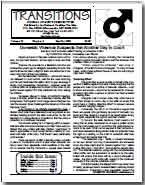
Domestic violence has been getting a lot of attention of late, as indeed it should. What has passed almost entirely without mention is that women are not the only ones to suffer abuse in its many and various forms. That men are also victims just doesn’t fit the feminist narrative
The ABC’s blue-ribbon documentary on domestic violence, Hitting Home, went to air on White Ribbon day this week to much acclaim and self-congratulation. For her six-months’ work, Sarah Ferguson is sure to be nominated for the year’s Gold Walkley. The two-part report depicted the truly appalling situation of women fleeing with their children to refuges to escape the repeated assaults of their partners which had turned them, in many cases, into passive, willing victims.
But in its dramatic mix of raw emotion and slick sentimentality, it told only the half of the story. In style and substance, it followed the proven Four Corners technique of restrictive focus that we saw Ferguson employ in her 2011 programme on Indonesian slaughterhouses. Hitting Home avoided – excluded, actually – all mention of domestic violence by women towards men. In an incredible one-third of all violence in the home, the man is the victim. When the tension rises to the point where the violence explodes to killing the children, women are worse than men.
Domestic violence is a much bigger and broader problem than the ABC would have us believe. The shame and sense of guilt at victimhood, articulated by women in the programme, are precisely the reasons men are reluctant to come forward. But more important, they have nowhere to go – the DV services for women are denied them. Police often laugh at their complaints.
Ferguson opened with vision of ambulances and police cars, setting the dramatic tone for the series she had been filming for six months “on the front lines of Australia’s domestic violence crisis.” There are 650 DV incidents a day, we were told on police authority. That is one incident every two minutes and 21 seconds, or 237,250 a year. (Is this correct?) It certainly sounded like a crisis, but it’s been well hidden, apparently.
“I’ve never really known what DV is,” said Ferguson in a walk to camera. “How does it start? How does it escalate from control to violence, even to death? Why do men do it – because it’s largely men – and why do women stay with them?”
I waited for the answers. I waited in vain.
But Ferguson’s words set the framework and themes for the next two hours. The report proceeded to depict the “what” of DV, but never ventured into the “why”. This was reduced to the simplistic, one-size-fits-all word: “control.” Men who are control freaks turn to violence when timid submission becomes a provocation, we were told. We waited in vain for an explanation of what drew these people together, why once-loving relationships go sour to the point of aggression, assault and damage.
One observation, not explored, is that the relationships were dysfunctional from the start. Most men and women appeared to be from the lower socio-economic levels, with limited education, interests or common purpose. Were they unable to withstand the financial, social and time limitations of family life? We were not told.
There are dimensions to the DV problem that Ferguson didn’t seem keen to explore — aspects that might have detracted from a neat depiction of female victimhood, and require more work than riding around in police cars and nursing the newborn. The One in Three Campaign aims to bring balance into the picture that programmes like Hitting Home distort. It lists the abuses of men, which take many of the same forms as those against women: physical violence, intimidation and threats, sexual, emotional and physical, verbal and financial abuse; property damage and social isolation. Legal and administrative abuse through false restraining orders, or not allowing access to children.
Discrimination against men is underlined by social marketing campaigns such as Violence Against Women, Australia Says No (Commonwealth) and Don’t Cross the Line (South Australia), both of which suggest that men are the only perpetrators, and women and children the only victims. The New South Wales Government has begun a scheme called It Stops Here Safer Pathway but its fact sheet does not mention that 31% of the 31,00 victims of DV assaults were men.
Any thought that women cannot be violent is dispelled by the homicide statistics compiled by the Australian Institute of Criminology. The May 2015 research report details homicides from 2002 to 2012. In that ten-year period, 186 people killed one or more of their children. Ninety-six, or 52%, were women; 90, or 48%, were men. And of the 654 homicide victims categorised as “intimate partners”, 166 or 25% were men. These figures suggest that Australian of the Year, Rosy Batty should widen her flagship campaign against domestic violence beyond standard feminist talking points.
Only those who have experienced what used to be called a “broken home”, or seen a marriage deteriorate to self-destruction could understand the complexity of human relationships that lead to violence and the police courts. The simplistic triumphalism of Hitting Home which purported to explain domestic violence in terms of control v. submission, brutality v. fear, male physicality v. female timidity did nothing but provoke emotionalism and irrationality. It seemed an apt political manifestation of the doctinaire feminism that now infects and dominates ABC culture.
Surely it’s time for a rational, balanced approach to a serious problem and a provocative challenge to society. This is how the Three in One Campaign sums it up:
Family violence and abuse can never be excused or justified, however, in order to reduce the levels of violence in the family, we must seek to understand the causes and contexts that give rise to it. We need to address the complexities of violence. All victims need compassionate and highly responsive support, and all perpetrators need services to help them stop their use of violence and abuse. Dysfunctional relationships in which both parties use violence need to be supported to change, as it is these environments that are clearly the most harmful to children.
Geoffrey Luck was an ABC journalist for 26 years



Leave a Reply